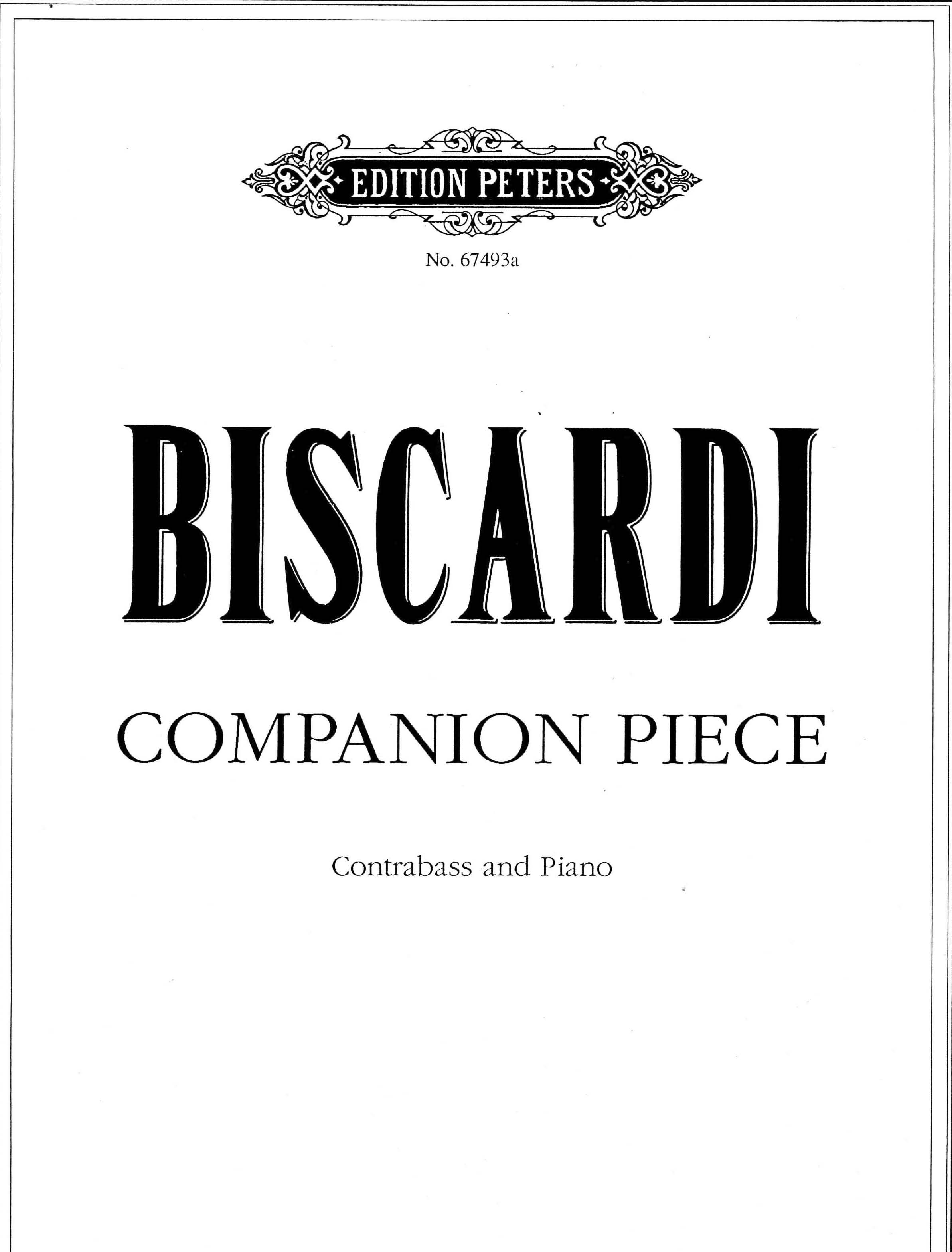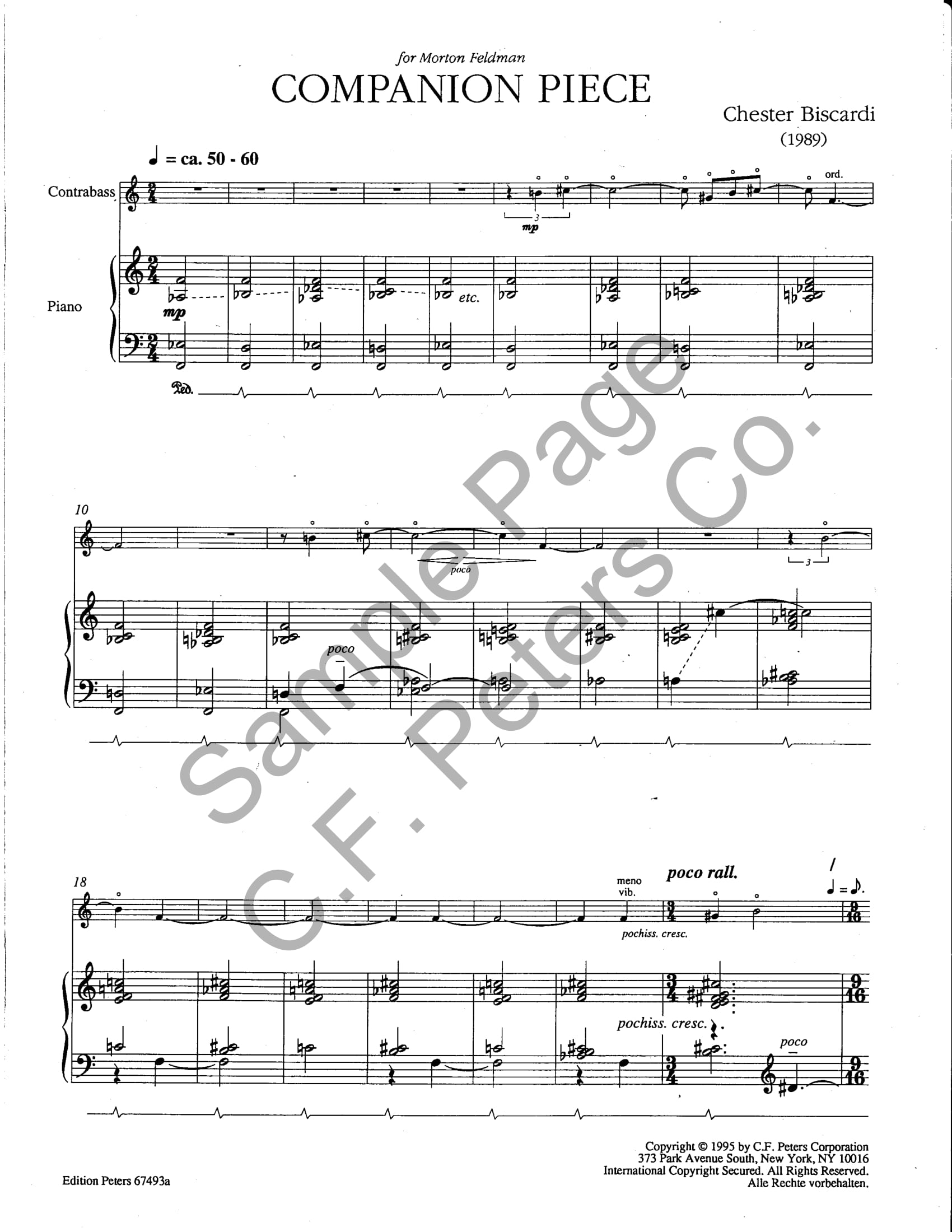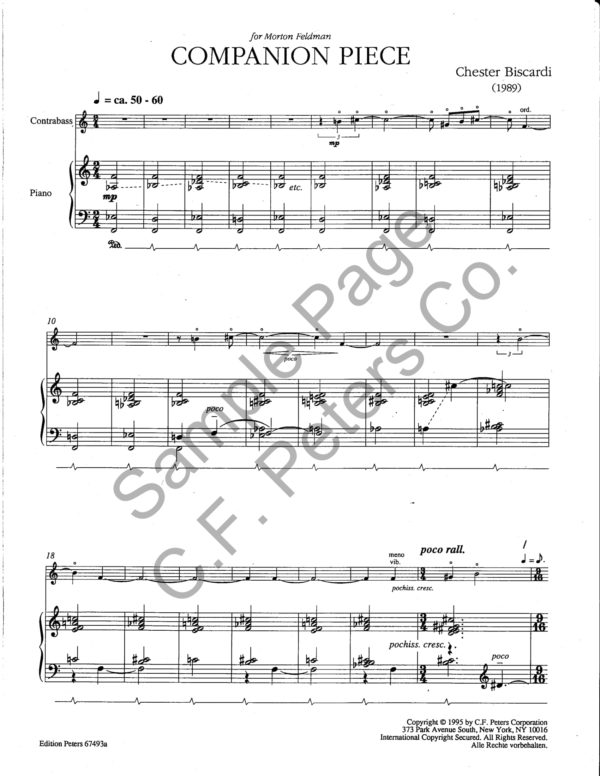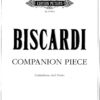Description
Audio
Mark Helias, contrabass; Marc Peloquin, piano
This recording appears on
Chester Biscardi: In Time's Unfolding, Naxos 8.559639 (Hong Kong, 2011) with
In Time's Unfolding,
Tartini,
Piano Quintet,
Mestiere,
Di Vivere, and
The Viola Had Suddenly Become a Voice.
Premiere
General Performance: 6 November 1989
Robert Black, contrabass / Anthony de Mare, piano
Faculty and Friends Series, Music at the University of Connecticut, Department of Music, School of Fine Arts
Storrs, CT
World Premiere: 20 November 1989
Robert Black, contrabass / Anthony de Mare, piano
Huddersfield Contemporary Music Festival
Huddersfield, Yorkshire, England
Bass clarinet version: 16 August 1990
Les Thimmig, bass clarinet / Anthony de Mare, piano
Lincoln Center Out-of-Doors Festival
New York, NY
Dedication
for Robert Black and Anthony de Mare
Commissioner
Commissioned by and written for Robert Black and Anthony de Mare
Publisher
C. F. Peters P67493a.
International Society of Bassists
Program Notes
Companion Piece (for Morton Feldman), for contrabass and piano (1989), was written for Robert Black and Anthony de Mare to be premiered at the Huddersfield Contemporary Music Festival in England on November 21, 1991. The work may be performed with bass clarinet and piano, from the original contrabass and piano score. There is also a solo piano version – premiered by Anthony de Mare at Sarah Lawrence College on November 21, 1991, and recorded on CRI CD 686 in 1995 – based on the original duet. Feldman: Homages; and Encounters with Feldman
I first met Morton Feldman in Buffalo in 1979. His apartment was neat, almost sparse: a Steinway, a work table, a Rauschenberg on one wall, the now-famous Brown/Feldman cover from TIME records on another, and many ancient Oriental, Turkish and Iroquois carpets. He talked about his music and compositional techniques that had as lasting an impact on me as did his intense passion for those carpets. He encouraged me to get close to the floor and look at their textures, reliefs, orchestration, what he called “symmetry even through imperfection,” and explained how he was translating these impressions into the musical notes of the string quartet that he was writing.
In my duet, I am commenting musically on Feldman’s Extensions 3, written for solo piano in 1952. I borrow two things from his work: 1) a quick juxtaposition of pianissimo (“Soft As Possible”) and fortissimo (“Loud As Possible”) in the way that soft sounds in my work are interrupted by unmotivated loud sounds; and 2) the last four bars of his piece – a poignant repeated figure – become a repetitive idea in Companion Piece that expresses loss and leads to stillness.
Feldman’s sounds are “drier”, more minimal than mine; I put the pedal down in a way that he never would in order to flesh out the notes with a different, “wetter”, more lush kind of harmony. The bass player has the difficult task of creating an illusion of pianissimo – almost in a trompe l’oeil fashion – by means of an intense, dynamic concentration and focus of sound.
The work may also be performed by bass clarinet and piano, from the original contrabass and piano score.
Press
"This six-and-a-half minute work is a musical comment on Morton Feldman's
Extensions 3. It is filled with modern, tangy chords. The bass sound is often deliberately enveloped by the piano sonority, tricking the listener (
trompe l'oeil?) as to exactly where the sound is coming from."
— Mark Morton, International Society of Bassists (1996)
Companion Piece (1989-91) . . . is the work that strikes me as an unqualified success. Written as an homage to Morton Feldman, it is a trope of sorts on Feldman's 1952
Extensions 3, also for solo piano. Something magical happens here, when the template of Feldman's soft, spacey gestures intersects with Biscardi's lush harmony. The Romantic gestures don't sound forced here, there's nothing kitsch about these beautiful chords, still more functional than Feldman would have ever made them but also less directed than American midcentury neo-Romanticism would normally allow. In short, very much of this time . . .
— Robert Carl, Fanfare, The Magazine for Serious Record Collectors (1995)
In what appear to by transitional pieces -
Incitation to Desire (1984),
Traverso, for flute and piano (1987), and
Companion Piece (1991), Biscardi's harmonies, no matter how arcane, show themselves to be never farther than the proverbial hair's breadth for the mainstream diatonicism that has informed so much of music's recent history. His subtle and often telling vacillation between these at once vastly separated and extremely close harmonic realms imbues these pieces with dynamism and expressiveness.
— William Zagorski, Fanfare, The Magazine for Serious Record Collectors (1995)
Music-lovers in whom the mere mention of Morton Feldman induces a feeling of drowsiness need not fear
Companion Piece. Though inspired by a visit Biscardi paid to Feldman's apartment, and borrowing one or two ideas from the latter's music, Biscardi himself admits, very politely, that "Feldman's sounds are 'drier', more minimal than mine." Companion Piece is a tonal, gently hypnotic, almost meditative work for piano and contrabass – a tranquil duet, although Biscardi also allows for the contrabass part to be omitted.
— Byzantion, MusicWeb International Classical Reviews (September 11, 2011)
The 1989
Companion Piece (for Morton Feldman) feels like a transitional work. Biscardi was close to Feldman (something you might not immediately infer from the music), and this work, while it has the sustained quiet of its dedicatee, is more openly expressive. Its harmonies are less juxtapositions of beautiful chords but actual progressions, no matter how laid-back. Mark Helias's playing is also exceptional; listening at first without reading any notes, I just assumed a cello instead of bass, as the sound is so light and "flutey."
— Robert Carl, Fanfare, The Magazine for Serious Record Collectors (January 2012)
Companion Piece (for Morton Feldman) (1989), for bass and piano, written for bassist Robert Black, doesn't sound much like Feldman, though it "comments" on his
Extensions 3 of 1952. Basically tonal and touching, like so much of this program, it is a sort of homage to the man he met in his student days and who had a lasting effect, but not an obviously musical one (at least on the basis of these works).
— Allen Gimbel, American Record Guide (November/December 2011)










